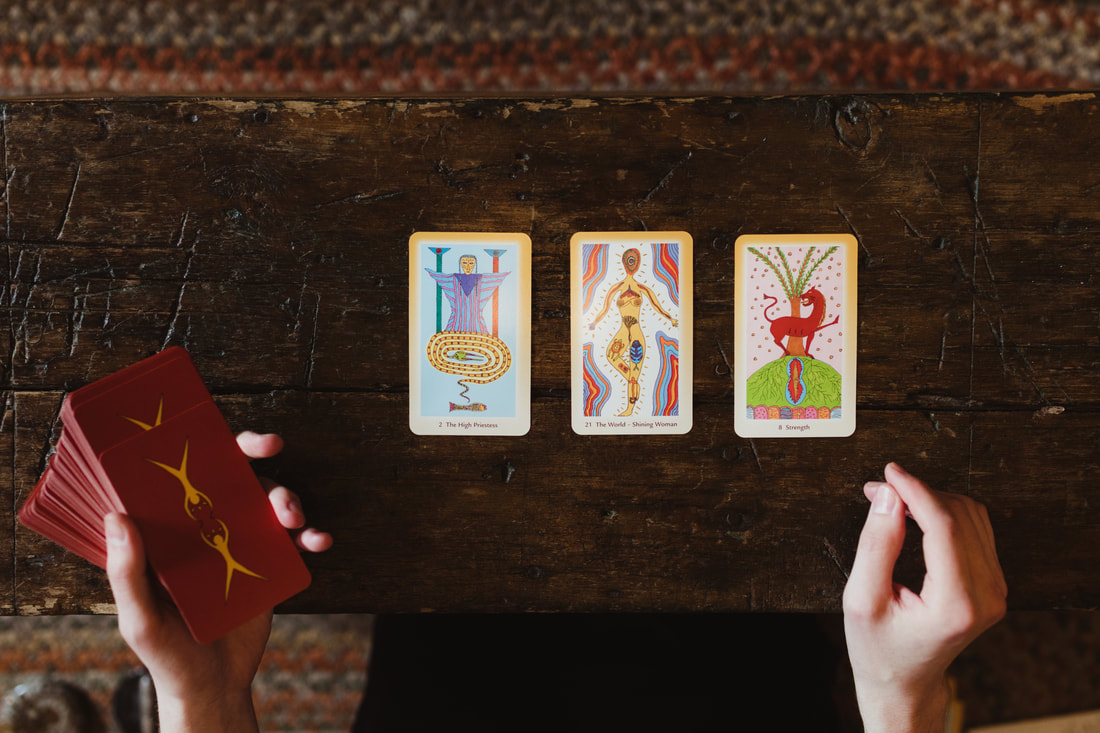|
I first began reading tarot as a freshman in college living in Jackson, Mississippi. Later that year, I took a series of tarot workshops with Mark McElroy at New Vibrations, a magical shop and haven for spiritual seekers that was tucked away in the arts district of Fondren in Jackson. Since then, tarot has been a regular practice of reflection, meaning-making, and divination in my life. I am currently studying The Living Tarot with T. Susan Chang and the Marseille Tarot with Camelia Elias.
At its most basic, tarot—like other forms of cartomancy—involves shuffling a deck of cards, drawing a card or series of cards that might be laid out in a specific pattern or spread, then interpreting the images on the cards in relation to one another and to a person's question or situation. There's a long history to reading tarot. The cards share a lineage with regular playing cards—an Arabic invention that began to appear in Europe around the 14th century—particularly in the division of the cards into four suits and the court cards. In the 1500s, decks were hand-painted and commissioned mostly by wealthy Italian families. These cards, called "carte da trionfi" or "cards of triumph" were used to play parlor games, and it is out of this tradition of playing games of chance and eventually story-telling with the cards that the practice of using the cards for divination likely emerged. It's not until the 18th century that any texts describing the mystical or divinatory uses of tarot appear. In 1909, one of the most famous tarot decks in history, illustrated by Pamela Colman Smith, was published. This deck, the best-selling deck of all time, was pivotal in the popularization of tarot. Today, we are living through a golden age of new tarot decks being created, many of them intentionally focused on including more diverse and inclusive representation. I highly recommend Asali Earthwork's "Tarot of the QTPOC: Deck Listing" for a living archive of decks doing this vital work. For me, tarot readings always start with a question. Camelia Elias, one of my tarot teachers, writes, "A witch is one who poses true questions"—and as a witch who reads tarot, this feels true to me. When I read for myself or for clients, a significant part of the work is coming to shape a question that is true. The formation and articulation of the question is already part of the divination. Reading cards in response to the question is a way of being with it, engaging the question, understanding it from the vantage of the specific cards that we pull, and in doing so, coming to greater perspective or understanding about the situation we are examining. I would not say that the purpose of the question is even to seek an answer. An "answer" feels like a reductive way to understand the question. As Bayo Akomolafe writes, "There are two ways to positively respond to a question ... One is by resolution. An answer, clarity ... The other is a rite of passage! Something takes the question and bends it this way and that until it becomes something else." He writes elsewhere, "But what if questions are not free-floating formations that are summarily resolved with answers? What if questions are not made only of words? What if questions are material things, speciated and tactile, with body parts, particular histories of their own, affective accompaniments, genealogical ties, and burial grounds? What if questions are like guests to a home—to be welcomed, catered to, dusted up, considered affectionately, spoken with, and put to bed? And what if giving an answer is sometimes the ethical equivalent of slamming a door on the face of a guest as soon as you’ve said hello?" In my practice, shuffling, drawing, and reading cards is a way of being with the questions, welcoming them, considering them affectionately, and speaking with them. We may not be seeking answers in tarot, but rather methods of being with the questions. Rather than putting our questions to rest, the cards put our questions into motion. My approach to reading tarot brings together traditional significations of the four suits, the four elements, and the major and minor arcana, with more immediate and sometimes intuitive responses to the images themselves. This way of reading has been deeply informed by my work and training in dance studies—watching dances, writing about dances, and teaching writing about dance. As with viewing and interpreting a dance, I find that the clearest and most meaningful interpretations of tarot cards are those that begin from direct engagement with the images themselves, then draw on familiarity with the deep structures and symbolism in each deck to develop and enrich those interpretations. Even after nearly 20 years of reading tarot, I also still consider what the creators of each deck have written about the cards in companion texts, not as a deference to some final authority, but as a way of reading with ancestors both living and no longer living. I find that bringing their words into the reading can be a way of opening the dialogue to further possibilities and insights. Altogether, what I see in the cards, whatever comes up for you, whatever we discuss, and how we call in the voices of others fold into one another in order to make connections, generate realizations, elaborate different directions of thought, and proliferate possibilities in our lives. I primarily read with the Shining Tribe Tarot, created and illustrated by Rachel Pollack; the Delta Enduring Tarot, created and illustrated by Egan; the Smith-Rider-Waite deck, illustrated by Pamela Coleman Smith and created in collaboration with Arthur Edward Waite; and the Mesquite Tarot created by Aleisha Fitz and Bronwyn Walls. I am also currently deepening my study and work with the Tarot de Marseille and Dori Midnight's Dirty Tarot. To schedule a tarot reading with me, please visit my Bookings page. You can also learn more about my approach to tarot from the recording of a tarot workshop I offered in 2021, available for immediate download. “What if, instead of providing a resolution, a direct answer, or a definite interpretation, a reading helped us to navigate the complexity of existence – attending to both its actual and virtual moments – its different positions, relationships and layers that also constitute us? Every reading exposes possibilities, reveals blockages, and shifts perspectives. Beyond the principles of non-contradiction and identity, readings design a space where multiple articulations of situations and events coexist without the imposition of a single meaning or direction.”
-Denise Ferreira da Silva & Valentina Desideri, “Poethical Readings” “Tarot is a practice of seeking clarity, of setting aside time for introspection and reflection. As in other meditative practices, it can give us perspective on the big things and the little things. It carves space to zoom out and gather insight that can assist us in making decisions that are rationally, emotionally, and spiritually intelligent … If we can better understand our own motivations, the light and dark within each of us, we can let go of fear. We can better understand others and begin to create healing in the larger world.” -Aleisha Fitz and Bronwyn Walls, creators of the Mesquite Tarot |
- Home
- About
- Bookings
- Offerings
- Events
- Tutoring and Mentorship
-
Downloads
- Transits and Transgender Liberation
- Feminist Astrology and the Moon
- Feminist Astrology: Mars, Violence, and War
- Celestial Kinship
- Introduction to Ritual Workshop + Beltane Ritual
- Minor Asteroids in the Birth Chart and Ritual
- Astrology Guide for 2022
- The Atomic Age, Urgency, Danger, and Kinship: Astrology and Climate Collapse
- Asteroids in Astrology: Nuance, Subtlety, and Direction
- Tarot Workshop with Michael J. Morris
- Astrology as an Artistic Practice: As It Is Made, So It Makes
- Astrology Guide for 2021
- Celestial Corporeality: Astrology and the Body
- Astrology Consultations as Feminist Praxis
- Embodying Astrological Archetypes
- Resources
- Blog
- Testimonials
- Policies
- Gratitude
Copyright © 2020

